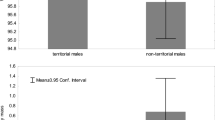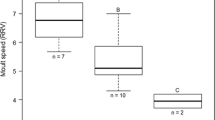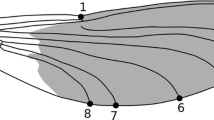Summary
Song flight, which is an aerial song display especially used by many open country bird species, is expected to be energetically very costly. Any morphological adaptation reducing the magnitude of this cost thus would be favored by selection. Male skylarks Alauda arvensis perform frequent song flights during a period of nearly half the year. Skylarks are sexually size dimorphic in most body traits, but particularly in wing area and wing span, which is absolutely and relatively larger in males than in females. Wing loadings, aspect ratios, and flight costs therefore are smaller in males than in females. I investigated the effect of wing area and aspect ratio on the duration of the song flights of individual birds by timing their duration before and after an experimental manipulation of wing area. Male skylarks were caught, ringed, and released (control I), had the tips of their wing feathers cut (control II), or had the tips of their wing feathers reduced by approximately 10 mm. There were no statistically significant differences in morphology or duration of songs between treatment groups before experimental treatments. However, males having the tips of their wing feathers reduced by ca. 10 mm performed only greatly abbreviated song flights. Original wing loading and aspect ratio also affected the duration of song flights, since male skylarks with low wing loadings and high aspect ratios performed longer song flights than did males with high wing loadings and low aspect ratios. This was the case both before and after experimental treatment. Wing area is suggested to reflect the ability of individual skylarks to invest in morphological structures allowing an increased song output.
Similar content being viewed by others
References
Alatalo RV, Höglund J, Lundberg A (1988) Sexual selective models and patterns of variation in tail ornaments in birds. Biol J Linn Soc 34:363–374
Andersson M (1982) Sexual selection, natural selection and quality advertisement. Biol J Linn Soc 17:375–395
Andersson M (1986) Evolution of condition-dependent sex ornaments and mating preferences: sexual selection based on viability differences. Evolution 40:804–816
Catchpole CK (1979) Vocal communication in birds. Edward Arnold, London
Catchpole CK (1982) The evolution of bird sounds in relation to mating and spacing behavior. In: Kroodsma DE, Miller EH (eds) Acoustic communication in birds. Academic Press, New York, pp 297–319
Davies NB, Lundberg A (1984) Food distribution and a variable mating system in the dunnock, Prunella modularis. J Anim Ecol 53:895–912
Delius JD (1963) Das Verhalten der Feldlerche. Z Tierpsychol 20:297–348
Delius JD (1965) A population study of skylarks. Ibis 107:466–492
Dominey WJ (1983) Sexual selection, additive genetic variance and the ‘phenotypic handicap’. J Theor Biol 101:495–502
Freeman S, Jackson WM (1990) Univariate metrics are not adequate to measure avian body size. Auk 107:69–74
Garson PJ, Hunter ML Jr (1979) Effects of temperature and time of year on the singing behaviour of wrens Troglodytes troglodytes and great tits Parus major. Ibis 121:481–487
Ginn HB, Melville DS (1983) Moult in birds. British trust for Ornithology, Tring
Gottlander K (1987) Variation in the song rate of the male pied flycatcher (Ficedula hypoleuca): causes and consequences. Anim Behav 35:1037–1043
Greig-Smith P (1983) Uses of perches as vantage points during foraging by male and female stonechats. Behaviour 86:215–235
Hails CJ (1979) A comparison of flight energetics in hirundines and other birds. Comp Biochem Physiol 63:581–585
Hamilton WD, Zuk M (1982) Heritable true fitness and bright birds: a role for parasites? Science 218:384–387
Higgens RM (1979) Temperature-related variation in the duration of morning song of the song thrush, Turdus ericetorum. Ibis 121:333–335
Hunter ML Jr (1980) Microhabitat selection for singing and other behaviour in great tits, Parus major: some visual and acoustical considerations. Anim Behav 28:468–475
Kodric-Brown A, Brown JH (1984) Truth in advertising: the kinds of traits favored by sexual selection. Am Nat 124:309–323
Lange H (1951) On the song-length in the sky-lark (Alauda arvensis). Dansk Ornithol Foren Tidsskr 45:34–43
Møller AP (1991a) Parasite load reduces song output in a passerine bird. Anim Behav (in press)
Møller AP (1991b) Why mated songbirds sing so much: mate guarding and male announcement of mate fertility status. Am Nat (in press)
Montgomerie RD, Kikkawa J (1989) Why do silvereyes sing at dawn? Abstract XXI Int Ethol Conf, Utrecht, The Netherlands
Morton ES (1982) Grading, discreteness, redundancy and motivation structural rules. In: Kroodsma DE, Miller EH (eds) Acoustic communication in birds, vol 1. Academic Press, New York, pp 183–212
Norberg UM (1985) Flying, gliding, soaring. In: Hildebrand M, Bramble DM, Liem KF, Wake DB (eds) Functional vertebrate morphology. Harvard University Press, Cambridge MA, pp 129–158
Norberg UM (1990) Vertebrate flight: mechanics, physiology, morphology, ecology and evolution. Springer, Berlin Heidelberg New York
Nur N, Hasson O (1984) Phenotypic plasticity and the handicap principle. J Theor Biol 110:275–297
Pätzold R (1983) Die Feldlerche. A Ziemsen, Wittenberg Lutherstadt
Payne RB, Payne K (1977) Social organization and mating success in local song populations of village indigobirds, Vidua chalybeata. Z Tierpsychol 45:113–173
Pennycuick CJ (1989) Bird flight performance: a practical calculation manual. Oxford University Press, Oxford
Rayner JMV (1988) Form and function in avian flight. Curr Ornithol 5:1–66
Reid ML (1987) Costliness and reliability in the singing vigour of Ipswich sparrows. Anim Behav 35:1735–1743
Searcy WA (1979) Female choice of mates: a general model for birds and its application to red-winged blackbirds (Aegelaius phoeniceus). Am Nat 114: 77–100
Searcy WA, Andersson M (1986) Sexual selection and the evolution of song. Annu Rev Ecol Syst 17:507–533
Slagsvold T (1973) Variation in song activity of passerine forest bird communities throughout the breeding season: special reference to the song thrush Turdus philomelos Brehm. Norw J Zool 21:139–158
Wilhelm K, Comtesse H, Pflumm W (1980) Zur Abhängigkeit des Gesangs vom Nahrungsangebot beim Glebbauchnektarvogel (Nectarinia venusta). Z Tierpsychol 54:185–202
Wilhelm K, Comtesse H, Pflumm W (1982) Einfluss der Konzentration der Zuckerlösung auf den Gesang und das Balzverhalten des Gelbbauchnektarvogels (Nectarinia venusta). Z Tierpsychol 60:27–40
Zahavi A (1975) Mate selection: a selection for a handicap. J Theor Biol 53:205–214
Zahavi A (1977) The cost of honesty (further remarks on the handicap principle). J Theor Biol 67:603–605
Author information
Authors and Affiliations
Rights and permissions
About this article
Cite this article
Pape Møller, A. Influence of wing and tail morphology on the duration of song flight in skylarks. Behav Ecol Sociobiol 28, 309–314 (1991). https://doi.org/10.1007/BF00164379
Received:
Accepted:
Issue Date:
DOI: https://doi.org/10.1007/BF00164379




